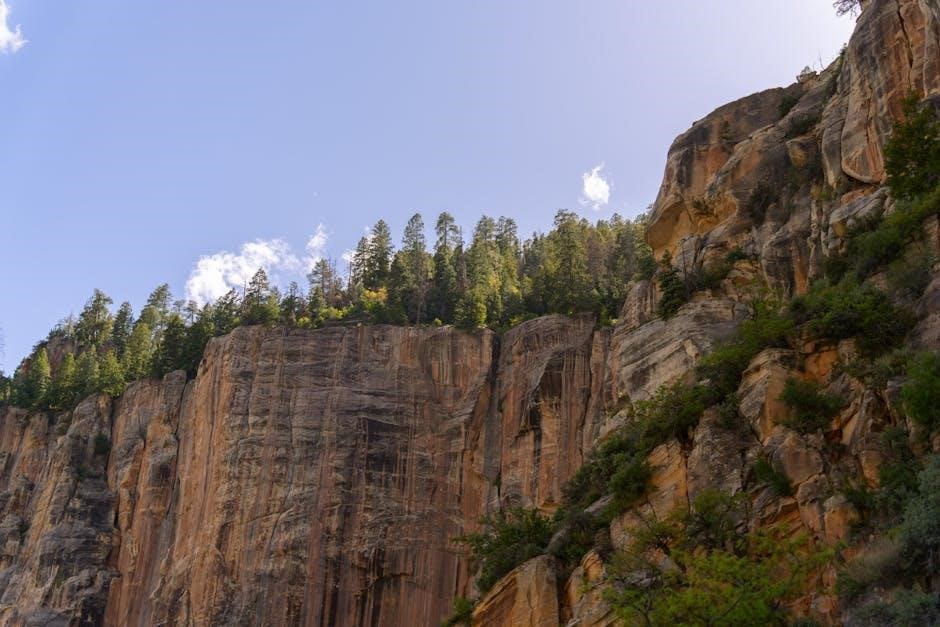
Overview of the Westward Expansion
Westward Expansion shaped America’s growth, driven by pioneers seeking land and opportunity. This movement transformed the U.S. into a continental power, impacting Native American communities and the environment.
Westward Expansion was a pivotal era in U.S. history, marking the movement of settlers from the eastern seaboard to the western frontier. Driven by the idea of Manifest Destiny, Americans sought land, economic opportunities, and political expansion. The Louisiana Purchase and the Cumberland Gap played crucial roles in facilitating migration. This period saw the displacement of Native American tribes, environmental changes, and the transformation of the U.S. into a continental power. Educational resources, such as worksheets, highlight key events and their impacts, helping students understand the complexities of this transformative chapter in American history. The westward movement shaped the nation’s identity, culture, and future.
Key Events in American History
The Louisiana Purchase of 1803 marked the beginning of significant westward expansion, doubling U.S. territory. The Cumberland Gap became a vital migration route for settlers heading west. Pioneers faced challenges like the Oregon Trail, which tested their resilience. The Mexican-American War resulted in the U.S. gaining vast territories, including California. The Homestead Act of 1862 encouraged settlers to claim land, fostering further expansion. These events shaped the nation’s geography, economy, and cultural identity. Worksheets on these topics help students analyze how these milestones transformed America into a continental power. Each event highlights the struggles and opportunities that defined the era, leaving a lasting legacy in American history.
Causes of Westward Expansion

Driven by Manifest Destiny, economic opportunities, and land hunger, Americans sought to expand westward, believing it was their divine right to claim the continent for agriculture and prosperity.
The Role of Manifest Destiny
Manifest Destiny was a powerful ideological force driving Westward Expansion, embodying the belief that the United States was destined to spread across North America. This concept, popularized in the 19th century, fueled the nation’s ambition to expand its territory, influenced policy decisions, and shaped the national mindset. It was often used to justify the acquisition of land, including the Louisiana Purchase and the annexation of Texas. The idea promoted the spread of American democracy, culture, and values, while also igniting debates over slavery and Native American displacement. By framing expansion as a divine mission, Manifest Destiny united the country under a shared vision, though its implementation had profound and often devastating consequences for indigenous populations and the environment.
Economic Opportunities and Land Hunger
Economic opportunities and land hunger were central drivers of Westward Expansion. Settlers sought fertile land for farming, mineral riches, and trade routes to bolster the U.S. economy. The idea of “land hunger” reflected the desire for vast territories to expand agriculture and settlements. Economic motivations included the promise of wealth from gold, silver, and other natural resources. The government supported expansion through policies like the Homestead Act, granting land to settlers. This quest for economic growth and land ownership shaped the nation’s identity and justified territorial acquisition, though it often came at the expense of Native American communities and ecosystems.

Key Figures in Westward Expansion
Pioneers like Daniel Boone and Sacagawea played crucial roles in exploring and settling new territories. Native American leaders resisted expansion, defending their lands and cultures.
Pioneers and Settlers
Pioneers and settlers were central to Westward Expansion, driven by the quest for land, economic opportunities, and a better life. These brave individuals faced immense challenges, including harsh terrain, disease, and conflicts with Native American tribes. Key figures like Daniel Boone and Sacagawea played pivotal roles in exploration and navigation. The Cumberland Gap became a critical migration route, guiding thousands to new territories. Settlers established communities, farmed the land, and laid the foundation for future growth. Their resilience and determination shaped the nation’s identity, transforming the U.S. into a continental power. However, their arrival also led to significant changes in the environment and Native American cultures, leaving a complex legacy.
Native American Leaders and Their Roles
Native American leaders played crucial roles during Westward Expansion, often resisting encroachment on their lands. Leaders like Geronimo and Sitting Bull fought to protect their tribes’ sovereignty, employing strategies ranging from diplomacy to armed resistance. Their efforts, though often unsuccessful against the U.S. military, highlighted the resilience and determination of Native American communities. These leaders also sought to preserve cultural traditions amid displacement and assimilation policies. Their stories reveal the profound impact of Westward Expansion on indigenous populations, emphasizing themes of loss, adaptation, and survival. Their legacies remain vital in understanding the complexities of this period in American history.

Impact of Westward Expansion
Westward Expansion transformed the U.S. into a continental power, causing Native American displacement, environmental degradation, and cultural clashes, while driving economic growth and societal change.
Effects on Native American Populations
The Westward Expansion had devastating effects on Native American populations. Many tribes were forcibly relocated, treaties were broken, and violence escalated. The loss of land and resources led to cultural destruction and starvation. Native Americans faced displacement, disease, and genocide, with their populations drastically declining. The U.S. government’s policies, such as Indian removal and assimilation, further eroded their sovereignty. The Trail of Tears, a brutal example, highlighted the suffering endured. Cultural traditions and languages were suppressed, leaving lasting scars. The expansion disrupted Native American ways of life, causing irreversible damage to their communities and identity, shaping a tragic chapter in American history.
Environmental and Cultural Changes
Westward Expansion brought significant environmental and cultural transformations. The vast landscapes were altered through deforestation, agriculture, and urbanization, leading to habitat destruction and changes in ecosystems. Native wildlife populations declined drastically due to overhunting and habitat loss. Culturally, the blending of settlers, Native Americans, and immigrants created a diverse society, fostering new traditions and folklore. However, this diversity often led to tensions and conflicts. The expansion also spurred technological advancements, such as the railroad, which further reshaped the environment and connected cultures; These changes profoundly impacted the nation’s identity, balancing progress with environmental and cultural challenges that continue to resonate today.
Worksheet Analysis
The worksheet provides structured exercises to explore Westward Expansion, offering questions on key events, environmental impacts, and cultural shifts. It enhances understanding through interactive learning activities.
Structure and Purpose of the Worksheet
The worksheet is designed to guide students through the analysis of Westward Expansion, featuring structured exercises like fill-in-the-blanks, multiple-choice questions, and short-answer prompts. It focuses on key events, such as the Louisiana Purchase and the Cumberland Gap, while assessing understanding of cultural and environmental impacts. The worksheet includes primary source excerpts and mapping activities to engage students with historical context. Questions are crafted to encourage critical thinking about the motivations and consequences of westward migration. Answer keys are provided for educators to evaluate student progress effectively. This resource serves as a comprehensive tool for interactive and inclusive learning, aligning with curriculum goals to foster deeper historical insights.

Common Questions and Answers

Q: What was the main route used by pioneers during Westward Expansion?
A: The Cumberland Gap was a key migration route for settlers heading west.
Q: How did the Louisiana Purchase impact Westward Expansion?
A: It doubled the size of the U.S., providing land for further settlement and growth.
Q: What was the role of Native Americans during this period?
A: Native Americans faced displacement and cultural disruption due to expanding settlements.
Q: Why was the Mississippi River important for settlers?
A: It served as a vital transportation route for trade and travel.
Q: Who was a notable figure in Westward Expansion?
A: Jed Smith was a prominent explorer and trapper who contributed to western mapping.
These questions and answers provide a foundational understanding of key events and figures in Westward Expansion, aligning with the worksheet’s educational goals.

Historical Context
Westward Expansion occurred in the early 19th century, transforming the U.S. into a continental power. It was driven by land acquisition, economic opportunities, and Manifest Destiny, impacting Native Americans and the environment.
The Louisiana Purchase and Its Significance
The Louisiana Purchase of 1803 marked a pivotal moment in U.S. history, doubling the nation’s size for $15 million. This land deal with France opened vast territories, including the Mississippi River and port of New Orleans, crucial for trade and expansion. It set the stage for westward growth, fulfilling American ambitions for a continental empire. The purchase not only expanded U.S. territory but also strengthened its economic and strategic position, paving the way for further exploration and settlement beyond the Appalachian Mountains. This acquisition remains a cornerstone of American expansionism, shaping the country’s future and its identity as a growing power.
The Cumberland Gap and Migration Routes
The Cumberland Gap, a natural mountain pass in the Appalachian Mountains, played a crucial role in Westward Expansion as a key migration route for settlers. Thousands of pioneers traversed this passage to move west, seeking land and opportunity. The Gap connected the eastern colonies to the western frontier, facilitating the spread of settlements beyond the Appalachians. It was also a vital route for the Wilderness Road, which became a primary pathway for westward migration. The Cumberland Gap symbolized the gateway to new territories, enabling the expansion of the United States and shaping the country’s territorial growth. Its significance lies in its role as a natural pathway that eased the challenges of frontier exploration and settlement.
Educational Strategies
Educational strategies focus on engaging students through interactive learning methods. Worksheets, discussions, and multimedia resources enhance understanding of historical events. Active learning fosters critical thinking and retention.
Teaching Westward Expansion in the Classroom
Teaching Westward Expansion effectively involves engaging students with interactive methods. Worksheets, such as those from America: The Story of Us, provide structured activities for analyzing primary sources, maps, and historical events. Classroom discussions encourage students to explore the motivations of pioneers and the impacts on Native American communities. Incorporating multimedia resources, like documentaries and timelines, enhances comprehension. Role-playing activities allow students to simulate decision-making processes faced by historical figures. Encouraging critical thinking through essay questions and group projects helps students connect past events to modern societal developments. By integrating diverse learning strategies, educators create a comprehensive understanding of this pivotal era in American history.
Using Worksheets for Interactive Learning
Worksheets are invaluable tools for interactive learning, fostering engagement and deeper understanding of historical concepts. The America: The Story of Us Westward Expansion worksheet encourages active participation through structured activities. Students analyze primary sources, complete map exercises, and respond to essay prompts, developing critical thinking skills. Interactive elements like fill-in-the-blank exercises and timeline completion enhance retention. Teachers can integrate these worksheets into group work, promoting collaboration and peer discussion. Visual aids, such as maps and images, cater to visual learners, while written responses allow students to articulate their thoughts clearly. Worksheets also provide immediate feedback, helping students identify areas for improvement and reinforcing key lessons about Westward Expansion.




